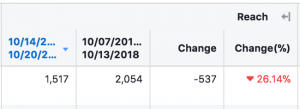After running your ad campaigns for a time, you will start collecting data. This data includes impressions, clicks, amount of people reached. This information is useful to figure it out what’s working and what’s not. To make sense of the data, you can slice them into groups. These groups are called dimensions. The most common dimension is time. You can group the data by week, by months or even years if you’ve been running your campaigns that long. So, how do you know if your campaign is performing better over time? It depends on the metric you choose to optimize. Let’s say you care about reaching more people:  In the graph above you can see a comparison between two weeks. In the second week, you’ve reached 26.14% fewer people, which mean your campaign is not performing well (from your goal’s point of view = reaching more people) Whatever you’ve changed in the second week, it didn’t work. Was it that you’ve reduced the audience? Did you allocate less budget per day? Once you’ve identified what it was, you can change it back, wait a week (not a day! you are comparing weeks here) and see if you are back on track.
In the graph above you can see a comparison between two weeks. In the second week, you’ve reached 26.14% fewer people, which mean your campaign is not performing well (from your goal’s point of view = reaching more people) Whatever you’ve changed in the second week, it didn’t work. Was it that you’ve reduced the audience? Did you allocate less budget per day? Once you’ve identified what it was, you can change it back, wait a week (not a day! you are comparing weeks here) and see if you are back on track.
 In the graph above you can see a comparison between two weeks. In the second week, you’ve reached 26.14% fewer people, which mean your campaign is not performing well (from your goal’s point of view = reaching more people) Whatever you’ve changed in the second week, it didn’t work. Was it that you’ve reduced the audience? Did you allocate less budget per day? Once you’ve identified what it was, you can change it back, wait a week (not a day! you are comparing weeks here) and see if you are back on track.
In the graph above you can see a comparison between two weeks. In the second week, you’ve reached 26.14% fewer people, which mean your campaign is not performing well (from your goal’s point of view = reaching more people) Whatever you’ve changed in the second week, it didn’t work. Was it that you’ve reduced the audience? Did you allocate less budget per day? Once you’ve identified what it was, you can change it back, wait a week (not a day! you are comparing weeks here) and see if you are back on track.Latest posts by Leo Celis (see all)
- From SaaS to AI Agents - 05/27/25
- The AI Automation Engineer - 05/13/25
- Hire One Developer to Press One Key - 05/06/25